Solitary Bees and Parasitic Flies
23rd May 2013
In: May 2013
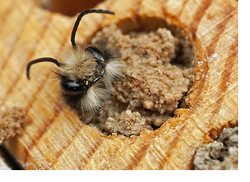 This photograph of a male Red Mason Bee (Osmia bicornis) chewing its way out of a nest burrow in my garden "bee hotel", confirmed that yet another mason bee nest had been successful. I guessed too, that other insects had probably benefitted from the hard work of last year's Osmia bicornis females.
This photograph of a male Red Mason Bee (Osmia bicornis) chewing its way out of a nest burrow in my garden "bee hotel", confirmed that yet another mason bee nest had been successful. I guessed too, that other insects had probably benefitted from the hard work of last year's Osmia bicornis females.I had designed my "bee hotel" last year and my brother-in-law had kindly constructed it for me. A dozen or so of the nest holes had been utilised by mason bees, but I had also seen some little (2-3mm) flies lurking around the stucture. These were the drosophilid flies Cacoxenus indagator that are attracted to the nests of solitary bees; particularly the Red Mason Bee.
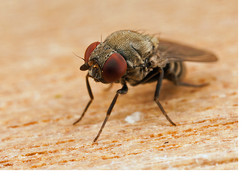 There has been more Cacoxenus activity this year, both at the "bee hotel" and around Red Mason Bee nests in my house wall. Like many other solitary bees, the Mason Bee provisions her nest hole with pollen and nectar stores, contained in individual brood cells. Each cell is separated by a wall of mud and a single egg is laid on each food store. Cacoxenus indagator females use these brood cells to lay around eight of their own eggs. The fly larvae consume the food store, depriving the bee larva of the food.
There has been more Cacoxenus activity this year, both at the "bee hotel" and around Red Mason Bee nests in my house wall. Like many other solitary bees, the Mason Bee provisions her nest hole with pollen and nectar stores, contained in individual brood cells. Each cell is separated by a wall of mud and a single egg is laid on each food store. Cacoxenus indagator females use these brood cells to lay around eight of their own eggs. The fly larvae consume the food store, depriving the bee larva of the food. 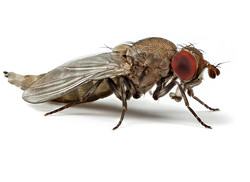 One morning this week, there was a sudden increase in Cacoxenus activity. I wondered whether there had been a successful emergence from one of the mason bee nests. My suspicions were confirmed when I found this teneral form near a nest opening. Insects in the teneral stage are newly-emerged from the pupal case (or nymphal skin) and their exoskeleton has not yet hardened or assumed the typical adult appearance. They are pale and soft and particularly vulnerable it this time. With a watercolour brush, I carefully transferred it to a white card and took a series of focussed-stacked images.
One morning this week, there was a sudden increase in Cacoxenus activity. I wondered whether there had been a successful emergence from one of the mason bee nests. My suspicions were confirmed when I found this teneral form near a nest opening. Insects in the teneral stage are newly-emerged from the pupal case (or nymphal skin) and their exoskeleton has not yet hardened or assumed the typical adult appearance. They are pale and soft and particularly vulnerable it this time. With a watercolour brush, I carefully transferred it to a white card and took a series of focussed-stacked images. 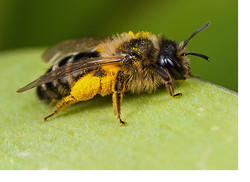 Andrena mining bees also attract the unwanted attention of members of the Diptera. Yesterday, I visited a colony of the Yellow-legged Mining Bee (Andrena flavipes) at a local churchyard. There are hundreds of nest holes under contruction in a mown, grassy area. It was rather cold, but quite a few females were returning with full pollen loads. I visit this site regularly and often see Leucophora flies there too. These are known as "satellite" flies and they follow female flies back to their nests, and as with Cacoxenus flies, lay their eggs in the mason bee burrows. Up until yesterday though, I has not properly observed their parasitic behaviour.
Andrena mining bees also attract the unwanted attention of members of the Diptera. Yesterday, I visited a colony of the Yellow-legged Mining Bee (Andrena flavipes) at a local churchyard. There are hundreds of nest holes under contruction in a mown, grassy area. It was rather cold, but quite a few females were returning with full pollen loads. I visit this site regularly and often see Leucophora flies there too. These are known as "satellite" flies and they follow female flies back to their nests, and as with Cacoxenus flies, lay their eggs in the mason bee burrows. Up until yesterday though, I has not properly observed their parasitic behaviour.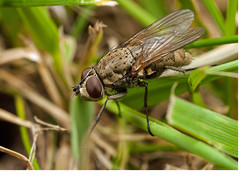 I saw lots of bees flying in and alighting near their burrows. Several had Leucophora flies flying just a few inches behind. The flies would wait until the bees had entered their burrows. Some bees were also returning to nearly leaves before actually going to their nest burrows. When they did this, the fly would land beside them and "harrass" them back into the air. I wondered whether the flies were possibly "hurrying" them back to their nests. I saw this happen quite a few times.
I saw lots of bees flying in and alighting near their burrows. Several had Leucophora flies flying just a few inches behind. The flies would wait until the bees had entered their burrows. Some bees were also returning to nearly leaves before actually going to their nest burrows. When they did this, the fly would land beside them and "harrass" them back into the air. I wondered whether the flies were possibly "hurrying" them back to their nests. I saw this happen quite a few times.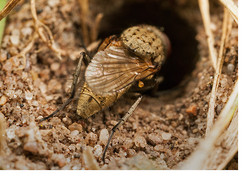 Here, a Leucophora fly has followed the bee to her nest burrow. The bee has disappeared inside and the fly is waiting by the hole. I was expecting it to wait until the bee had emerged before entering the hole itself. It didn't though.
Here, a Leucophora fly has followed the bee to her nest burrow. The bee has disappeared inside and the fly is waiting by the hole. I was expecting it to wait until the bee had emerged before entering the hole itself. It didn't though.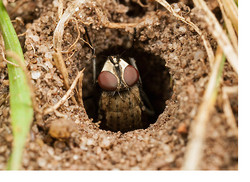 The fly entered the hole and a few seconds later, emerged, turned around and reversed back in. The fly was inside for several minutes and then emerged. Presumably, the egg-laying had been completed. There was no sign of the Andrena bee during this process.
The fly entered the hole and a few seconds later, emerged, turned around and reversed back in. The fly was inside for several minutes and then emerged. Presumably, the egg-laying had been completed. There was no sign of the Andrena bee during this process.It's not just some Diptera that parasitise solitary bee nests. About a third of solitary bees are actually parasites of other bees! Of these cleptoparasitic (nest-stealing), or cuckoo bees, Andrena flavipes has its own specific parasite - Nomada fucata. I haven't seen this at the colony yet this year but I'll go back again soon and see if I can photograph it.
Comments
 By Amelia: I've never seen pictures of flies going into Mason bee nests. Those are great shots. I am now starting to look at flies very suspiciously and I am taking pictures of them where bees are nesting. I am in the UK for a couple of weeks and I have Osmia I have never seen nesting in an old table top in my daughter's garden and I have seen and photographed Bombus hypnorum for the first time in a niece's garden, so I'm very pleased.
By Amelia: I've never seen pictures of flies going into Mason bee nests. Those are great shots. I am now starting to look at flies very suspiciously and I am taking pictures of them where bees are nesting. I am in the UK for a couple of weeks and I have Osmia I have never seen nesting in an old table top in my daughter's garden and I have seen and photographed Bombus hypnorum for the first time in a niece's garden, so I'm very pleased. By AnnoraBee: I have seen this behavior in flies with Andrena bees so many times and was finally confused enough that I looked it up. Thanks for the info and the photos!
By AnnoraBee: I have seen this behavior in flies with Andrena bees so many times and was finally confused enough that I looked it up. Thanks for the info and the photos! By Rainer: Dear Ed,
I noticed these lttle flies at our garden bee hotel and i was suspecting the possibility that they somehow relate. Great photos and very useful information. Thank you! Any ideas how to control defeat them?
best wishes
Rainer
By Rainer: Dear Ed,
I noticed these lttle flies at our garden bee hotel and i was suspecting the possibility that they somehow relate. Great photos and very useful information. Thank you! Any ideas how to control defeat them?
best wishes
Rainer By Jean: Thanks Ed, that's really helpful as I'd just been watching an Andrena cineraria popping down into a nest hole and spotted a furtive little fly hanging around.I found your article while searching for clues as to what it was, so now I know it was a Leucophora. It sneaked into the hole while the bee was still in there but it didn't get chance to reverse in and do any egg laying as the bee was obviously working quite close to the nest entrance and kept popping back up. Fascinating to watch!
By Jean: Thanks Ed, that's really helpful as I'd just been watching an Andrena cineraria popping down into a nest hole and spotted a furtive little fly hanging around.I found your article while searching for clues as to what it was, so now I know it was a Leucophora. It sneaked into the hole while the bee was still in there but it didn't get chance to reverse in and do any egg laying as the bee was obviously working quite close to the nest entrance and kept popping back up. Fascinating to watch! By Barbara Babington: Hi, I was hoping I could pick your brain 😊.
I'm struggling to identify which insect laid it's egg in one of my solitary bee hotels, it looks like individual cells within a cell. White grubs, I'm very familiar with parasites in a bee hotel. Could you send me you email so I might send you some images please.
Kind Regards
Barbara
By Barbara Babington: Hi, I was hoping I could pick your brain 😊.
I'm struggling to identify which insect laid it's egg in one of my solitary bee hotels, it looks like individual cells within a cell. White grubs, I'm very familiar with parasites in a bee hotel. Could you send me you email so I might send you some images please.
Kind Regards
Barbara